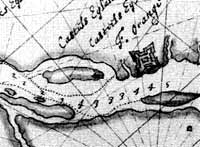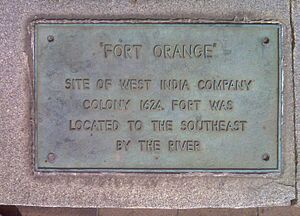Fort Orange (New Netherland) facts for kids
|
Fort Orange Archeological Site
|
|
| Location | Albany, New York |
|---|---|
| Built | 1624 |
| NRHP reference No. | 93001620 |
Quick facts for kids Significant dates |
|
| Added to NRHP | November 4, 1993 |
| Designated NHL | November 4, 1993 |
Fort Orange (Dutch: Fort Oranje) was the very first permanent Dutch settlement in New Netherland. Today, the city of Albany, New York, stands where this fort once was. It was built in 1624.
Fort Orange replaced an older trading post called Fort Nassau. That fort was on nearby Castle Island. It had to be left in 1617 or 1618 because of frequent floods. Both forts were named to honor the Dutch House of Orange-Nassau.
Later, there was a disagreement between the leader of New Netherland and the owner of a large land area called Rensselaerswyck. This disagreement was about who controlled the fort and the area around it. Because of this, the fort and its community became an independent town. This helped lead to the future city of Albany.
When the English took over the region, they renamed Fort Orange to Fort Albany. But they soon stopped using it. In 1676, they built a new fort called Fort Frederick.
Contents
History of Fort Orange

In 1624, a ship carrying 30 Protestant Walloons arrived in New Netherland. These were French-speaking people from what is now southern Belgium. Eighteen of these men were sent to the area near present-day Albany.
The Dutch told them to build Fort Orange. It was about 2 miles (3 km) north of the old Fort Nassau, which often flooded. The new fort was also about five miles south of where the Mohawk River meets the North River (now called the Hudson River).
The Walloons were later called south to help settle New Amsterdam. A report from 1628 said that "there are no families at Fort Orange." It mentioned that only "five or six and twenty (25 or 26) persons, traders," lived there.
In 1626, the commander of Fort Orange and his men left the fort. They went to help the Mahican people in their war against the Mohawk. The Mohawk were a powerful Iroquois tribe living west of the fort. The Dutch group was attacked about a mile from the fort. Three men were killed. This area is roughly where Lincoln Park and Delaware Avenue are today.
The Dutch built Fort Orange without asking the Native Americans. They kept control of it only because the Mahican people were friendly. They also gave the Mahicans gifts from time to time.
Establishing Rensselaerswyck
In 1629, the Dutch created the Charter of Freedoms and Exemptions. This set up a system where wealthy people could become "patroons" and own large areas of land. Kiliaen van Rensselaer started his patroonship, Rensselaerswyck.
This huge area surrounded Fort Orange. It stretched 24 miles (39 km) along the Hudson River and 24 miles (39 km) inland on both sides of the fort. Van Rensselaer believed his land included Fort Orange and the small town growing outside its walls. He began buying land from the Mahican people.
In 1630, the first permanent Dutch farmers came to Fort Orange. They settled just outside the fort. Their village was first called the Fuyck, and later Beverwyck.
In 1634, the commander of Fort Orange sent Harmen Meyndertsz van den Bogaert west. He traveled into Mohawk and Oneida lands. His goal was to find out why the fur trade was slowing down. This journey lasted six weeks and covered at least 100 miles (160 km) from the fort. Bogaert wrote about his trip in a daily journal.
In the 1640s, a French Jesuit priest, Isaac Jogues, visited Fort Orange. He described it as "a wretched little fort." He said it was "built of stakes, with four or five pieces of cannon."
Disputes and Changes
In 1648, a disagreement started between the Dutch West India Company and the patroon. They argued over who controlled Fort Orange and the nearby settlement. The leader of New Netherland, Pieter Stuyvesant, represented the West India Company. He saw the patroon's power as a threat to the company's profits from the beaver pelt trade at Fort Orange.
Stuyvesant first ordered all buildings near the fort to be destroyed. He then changed this to only buildings within musket shot. In response, the patroon's agent decided to build even closer to the fort.
After floods damaged the fort, the West India Company decided to rebuild it with stone. But the patroon's agent made it illegal to get stone from Rensselaerswyck. All building materials had to be brought from outside the colony. The patroon's agent claimed Fort Orange was built illegally on his land. Stuyvesant argued that the fort was built 15 years before Rensselaerswyck was even created.
In 1651, Stuyvesant declared that the fort's area extended 600 paces around it. This separated it from Rensselaerswyck. He then appointed Johannes Dyckman to oversee the fort. In 1652, Stuyvesant created a "Court of Justice for the Village of Beverwyck." This was the first local government for what would become Albany.
Beverwyck had about 100 buildings next to the fort. Stuyvesant moved Beverwyck a bit further away from the fort's cannons. He also laid out Albany's oldest streets, State Street and Broadway.
By the late 1650s, the fort was falling apart again. In 1660, both Fort Orange and Beverwyck were surrounded by a wooden fence for protection.
English Takeover
In 1663, smallpox spread rapidly in Fort Orange. It killed one person a day, which was a lot for such a small population.
On September 8, 1664, the English sent many warships to New Amsterdam. They demanded that New Netherland surrender. The Dutch agreed. New Netherland became the Province of New York. New Amsterdam was renamed New York.
Johannes De Decker sailed from New Amsterdam to Fort Orange. He tried to get the soldiers and settlers to fight the English. On September 10, Governor Nicholls sent troops to demand the peaceful surrender of "Fort Aurania." Aurania was the Latin name the English used for Fort Orange.
On September 24, 1664, the Dutch leader, Johannes de Montagne, finally surrendered the fort to the English. Colonel George Cartwright took command. The next day, Captain John Manning gained control of the fort. It was renamed Fort Albany. Beverwyck was also renamed Albany.
In 1673, the Dutch briefly retook New York City. They named it New Orange. On August 3, they also retook Albany. In September, Albany was renamed Willemstadt, and Fort Albany became Fort Nassau. However, the Treaty of Westminster, signed in 1674, gave the lands back to the English. New Orange and Willemstadt went back to their English names. Fort Nassau became Fort Albany again, and Willemstadt became Albany.
In 1666, Jeremias van Rensselaer, the patroon of Rensselaerswyck, asked the new English governor to recognize Fort Albany as part of his land. The governor told him to drop the matter. In 1678, Governor Andros confirmed the patroon's rights over Rensselaerswyck. But he specifically left out Fort Albany and the area right around it.
The English stopped using Fort Orange. They built a new fort called Fort Frederick on State Street Hill. This new fort protected the settlement from the Mohawk and other Iroquois tribes. It was also on high ground, reminding the Dutch people that the English were in charge.
The land around the old Fort Orange was sold to the Dutch Reformed Church for use as pasture. The fort itself continued to fall apart. Maps in the 1700s showed it as "ruins of an Old Fort." By 1769, a traveler named Richard Smith noted that "nothing to be seen of Fort Orange... but the Ditch which surrounded it." After the American Revolutionary War, the old fort site was remembered as a historic place. Many historical events were held there.
Later Discoveries
Simeon De Witt built a large house on the site of the old fort in the 1790s. The address became 549 South Market Street (later Broadway). Traces of the old fort could still be seen on his property as late as 1812. After he died, his house became the Fort Orange Hotel. It burned down in 1848 but was rebuilt under the same name.
In 1886, Albany celebrated its 200th birthday as a city. As part of this, a bronze plaque was placed where the fort's northeastern corner used to be. In the 1930s, this plaque was moved during the building of the Dunn Memorial Bridge. For almost 100 years, it did not mark the actual fort site. The Albany Institute of History and Art has a cannonball found at the site in 1886.
The plaque was moved again in 1971. This happened after excavations found parts of the fort during the building of Interstate 787. The marker was returned to the Fort Orange site, but not to its exact original spot.
The area of the fort was named a National Historic Landmark on November 4, 1993. It was also added to the National Register of Historic Places.
Commanders of the Fort
Here are some of the people who commanded Fort Orange:
- Adriaen Jorrissen Thienpont
- Daniel van Krieckebeck (killed by Mohawks in 1626)
- Bastiaen Jansz Krol (appointed after Krieckebeck's death)
- Hans Jorissen Houten
- Carl van Brugge
- Johannes Dyckman
- Johannes de Decker
- Johannes de la Montagne
As Fort Albany (English Rule)
- Captain John Manning
- Captain John Baker
As Fort Nassau (Brief Dutch Return)
- Lieutenant Andries Draeyer
Excavations and Artifacts

Before the excavations in the 1970s, no Dutch artifacts from the 1600s had been found in Albany. The New York State Historic Trust and the New York State Department of Transportation carried out these digs. They worked from October 1970 to March 1971.
The first test dig was in the cellar of the De Witt house. This area had no remains of the old fort. But digging under Broadway, in front of the house, uncovered many items from the Dutch colonial past. These included a Jew's harp, tobacco pipes, beads, Rhenish stoneware, and Delftware.
The excavations also found the fort's south moat (a ditch around it). They found a pebbled path from the fort's east entrance. They also discovered a brewery built in 1647 and parts of several houses.
From the findings, experts learned that venison (deer meat) was the main meat eaten by the fort's settlers. Pork was the second most common. Many fish bones and scales were found in a pit from before 1648. Sturgeon fish were found less often in later years.
Eating and drinking items included different types of pottery and glass. These were lead-glazed earthenware, tin earthenware, Rhenish stoneware, Chinese porcelain, and various glass cups. Before 1650, the tin-glazed earthenware was mostly maiolica (a type of Italian pottery). Porcelain was rare, found only as a few broken pieces.
Many clay pipes were found, often with the "EB" mark of Eduard Bird from Amsterdam. The site was used continuously, so artifacts from the 1830s and 1860s were also found. All the artifacts from the excavation are now kept at the New York State Museum.
See also
 In Spanish: Fort Oranje (Nuevos Países Bajos) para niños
In Spanish: Fort Oranje (Nuevos Países Bajos) para niños



